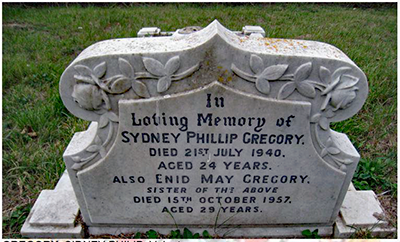Second World War - Lynsted Memorial Project
Sydney Philip GREGORY (of Oare)
b. 31st March1916 Home Guard (and Brickworks sorter) |

Sydney was born on 31 March 1916 to Stanley Arthur and Hilda May Gregory. Sydney married Rosina Doris Davis in Oare Church on 29 October 1938. At the time of the 1939 Register they were living a short distance from his parents at 4 Amos Cottages, Oare, along with their new-born daughter, Margaret. Sidney worked as a sorter at the brickworks.
On the night of 19 July 1940, air raids in the south-east saw six high explosive bombs fall on Church Road, Oare. On hearing the siren, Sydney left his home to fetch his wife from a neighbour's house just as a bomb fell in the garden. Two further bombs fell in an adjoining field cropped with beans. Sadly, Sydney had been fatally injured and succumbed to his injuries the following day. Mrs Flora Jenkins and Alice Hill were also injured, thankfully not seriously.
Sydney is buried in Oare Churchyard. He is also commemorated on the Davington School memorial plaque, located in the parish church of St. Mary Magdalene & St. Lawrence, Davington.
Died on 21 July 1940, following a bomb blast in Oare the previous day, aged 24.
Contextual Newspaper Report on 'taking cover'
The week beginning 19th July 1940 was widely reported as featuring large Channel and Thames bombing and strafing incidents, including coastal towns. This early in the war, the opportunity was taken to remind civilians to take cover and properly prepare their shelters.
26th July 1940 – Dover Express
"LESSONS OF THE AIR RAIDS. IMPORTANCE OF TAKING COVER.
Of 33 air raid casualties in two towns recently 20 occurred in the open and only 13 in buildings; 17 were from flying glass and six from bomb splinters. This analysis was given by Sir Alexander Rouse, Chief Engineer to the Home Office, broadcasting on Sunday night. He emphasised the importance of taking cover and of avoiding flying glass.
He said that he was astounded to find that many people had not covered their Anderson shelters properly. In one recent case, a bomb caused injury from splinters to six occupants of a shelter which had no earth covering at the back, but occupants of properly protecting shelters near bomb craters had escaped. One explosion pushed the last man into the shelter, which was telescoped by the force of it. But, as it was well covered, there were no casualties. Results had also been satisfactory from brick and concrete shelters and trenches.
Houses provided a considerable measure of protection. An elderly woman and a child in the staircase well of a damaged house were rescued from the debris unhurt, while five people were killed in larger rooms. Sir Alexander urged people to learn to deal with incendiary bombs. They need not be afraid to do so. Fourteen fires started in a town where 100 such bombs were dropped on houses and streets were put out by inhabitants using stirrup pumps and other means.
Among other points of advice were:- Go quickly to your shelter or refuge room; suppress your curiosity and don't "good"; don't wait for the local authority to come and make safe your shelter for you. We are all soldiers in this war and the soldier doesn't wait for the sapper to dig trenches for him."

